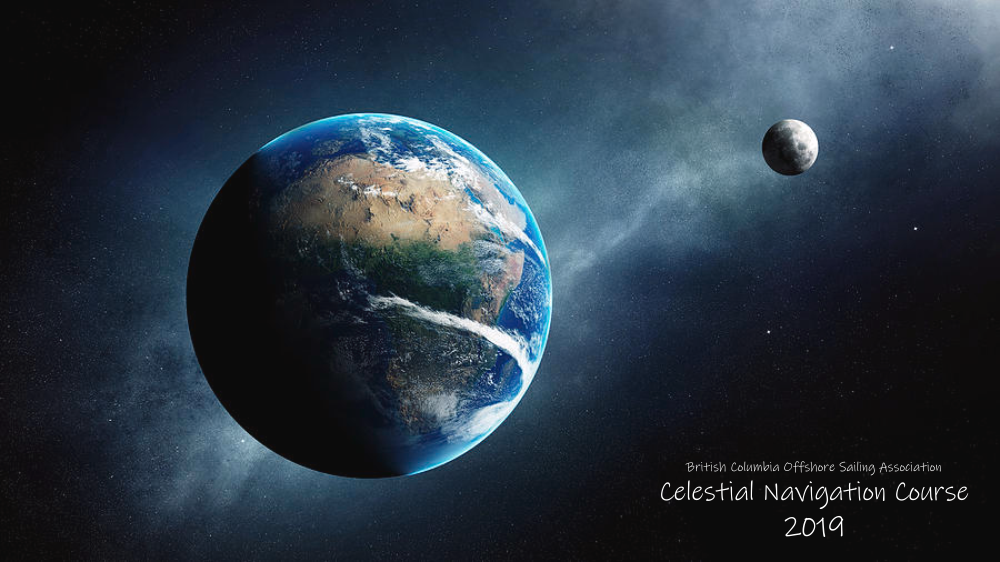Table of Contents
Class Objective
Pre-Class Prep
Class 1
Class 2
Class 3
Class 4
Class 5
Class 6
Class 7
Class 8
Class 9
Class 10
>>Topical Articles<<
Assumed Longitude
Bowditch
Bygrave
Casio fx-260 Solar II
Emergency Navigation
Making a Kamal
Noon Sight
Pub. 249 Vol. 1
Sextant Adjustment
Sextant Skills
Sight Averaging
Sight Planning,
Error Ellipses,
& Cocked Hats
Slide Rules
Standard Terminology
Star Chart
The Raft Book
Time
Worksheet Logic
BCOSA.ca

Overall Course Objective
That by the end of this course, you should be able to navigate yourself across any ocean in the world with no more hardware than your sextant and a wristwatch.
Long Term Achievables: 300 Hours to Mastery
Celestial navigation is a well-bounded skill set. That is, you can learn everything you need to know, and even achieve mastery of the skill, in a reasonable length of time.
In this, it is not unlike learning knots for sailing. While you could devote an almost endless amount of effort learning decorative rope work, in practice if you learn a half-dozen hitches and bends, you have basically mastered all you need as a small boat sailor. You need learn no more, and can devote most of your energy to sailing the boat, and enjoying the next sunset.
So also with celestial navigation.
You start by learning the basics in 30 hours of class work. Then devote another 270 hours of practice, such that you get to the place where you can take a sight of the sun (or moon, or planet, or star) and work it up in 15 minutes or so, combine it with another sight and come up with a fix that is accurate to within 3 or 4 nm. At that point, you will have mastered this navigational skill and can get on with enjoying the next sunset.
Go Deeper by Instructing
There are some who - even after mastering practical celestial navigation - find that they are still intrigued by the area. If you want to go deeper, there will be several options for you. You may, like Bob, start instructing others in celestial navigation. The challenge of making these concepts more easily digested by newcomers will certainly keep your mind challenged.
Go Deeper Through Art
Another option might be to seek to find ways to incorporate navigational concepts into public art works.
Carly spent a good bit of time working out how to teach 10 year old children about the movement of the sun by using a globe and a laser...with the idea of building an enormous sun-dial on the beach near the school where the children study.
Go Deeper Through History
Yet another option is to delve into the history of navigation. There is a whole on-line community of people who are intrigued by pre-modern celestial navigation.
Navlist, at http://fer3.com/arc/ is a community of people from around the world who are fascinated by celestial navigation — and particularly celestial navigation as it was practiced 85 years ago...or 185 years ago.
Perhaps you are interested in what sort of sextants 747 airliners used to navigate across oceans back in the 70s.
Or going further back in time, to learn how Francis Chichester used a marine sextant to navigate the first solo aircraft flight from New Zealand to Australia in 1931.
Chichester was flying a bi-plane with an open cockpit. At one point, he wanted to take a sun sight, but on his current course, the sun was hidden behind his upper wing. The solution he came up with was to put the plane into a dive, hold the stick between his knees so he could steer straight, and take his sextant sight...making sure to complete his sight quickly enough that he could pull up out of the dive and avoid crashing into the ocean.
Or you are interested in learning about how to use tables that were published decades before Pub. 249 came out.
Or maybe you want to reduce sights without using tables at all...just using a slide rule.
Or going further yet back in history, this is the place to be if you are interested in determining the time (and hence, longitude) without a clock, by measuring the angular distance between the moon and a given star.
If you have a nostalgia for pre-modern celestial navigation, this is definitely the group to join.